The world of work has undergone a significant transformation in recent times, as we continue to adapt to the post-covid business landscape. In this new normal, a concept that has gained a huge degree of popularity is hybrid working.
With its unique blend of remote and in-office work arrangements, hybrid working offers employees flexibility and companies the potential to optimise productivity – but creating policy that sticks in this new world of work is no easy feat.
We’re talking to companies of all shapes and sizes about their workplace strategy every day, and we’re often asked the same question when it comes to the return-to-office: ‘What is everyone else doing?’
There isn't a one-size-fits-all hybrid policy to replicate, but we're starting to see patterns emerging in the steps that businesses are taking in order to get to their own version of what great looks like.
This guide will walk you through those steps to help you navigate the complexities of hybrid working – and reap the benefits it offers.
In this blog:
- Benefits of a hybrid work policy
- Examples of different hybrid policies
- 6 steps to implementing a hybrid policy
Benefits of a hybrid work policy
While many companies have decided that they do want employees brought together for at least some of the week, a huge number of them are still yet to implement clear policy or structure that incentivises them to do so.
We work with a number of businesses across London, and find that those with a policy around days in the office are finding a greater engagement in the post-covid world of work than those without one.
Streamlined communication
For growing companies, or those with ambitions to grow, in-office days enable teams to come together to solve problems at speed, collaborate and innovate in a way that’s difficult to replicate in a remote working environment.
The varying stages of growth often mean that things change quickly. Whether it’s new policies, new hires or new products, bringing people together so everyone can get on the same page is fundamental to success.
Employee engagement and company culture
Whether moving from no policy at all or refining one that hasn't quite landed, cementing days in which your team can all come together will have a huge impact on company culture.
From cross-pollination to living and breathing company values in-person, those interactions that employees have in the workplace are difficult to replicate remotely.
Cost-saving
Implementing a hybrid working model has the potential to lead to cost-saving down the line, particularly with regard to office space. Many businesses have found that in this new world of work, workspace is rarely at full capacity and employees coming into the office are looking for more than just desk space.
Whether it's optimising existing space to cut on furniture costs or downsizing to a smaller office, a hybrid working policy that provides clarity on how many employees need to use the space and when will enable business leaders to reevaluate their requirements in both the short and long-term.
Examples of different hybrid policies
There is no cookie cutter hybrid work policy, but businesses looking to implement one typically land on an approach that falls into one of the following three categories.
1) Team policy: Managers set out policies for their teams in line with the business needs and goals.
2) Fixed days: Typically set at a company level, meaning everyone from across the business is in on the same day(s).
3) Flexible: Employees are expected to be in for a number of days per week, fortnight or month, but have the freedom to choose which days.
Team-based policy
A policy centred around aligning different teams on certain days can be really beneficial for a number of reasons. This puts a chunk of the responsibility on team leads or heads of departments to decide which teams they need to collaborate with, and on which days that will take place.
This is typically used by larger corporations because it can be designed strategically to help reduce space. It can also work for smaller companies that might be bursting at the seams – it allows you to be more efficient with the space that you have by creating natural adjacencies between teams.
Here's an example from one of our clients, who have a relatively small space but a growing team. They're a SaaS company with a large sales and marketing arm, and they wanted to align at least twice a week. On 'team days', desks areas are assigned to specific teams so that they're guaranteed a seat.
They leave a few spare banks of desks for hot-desking, and on Fridays the whole office is open to anyone who wants to come in.
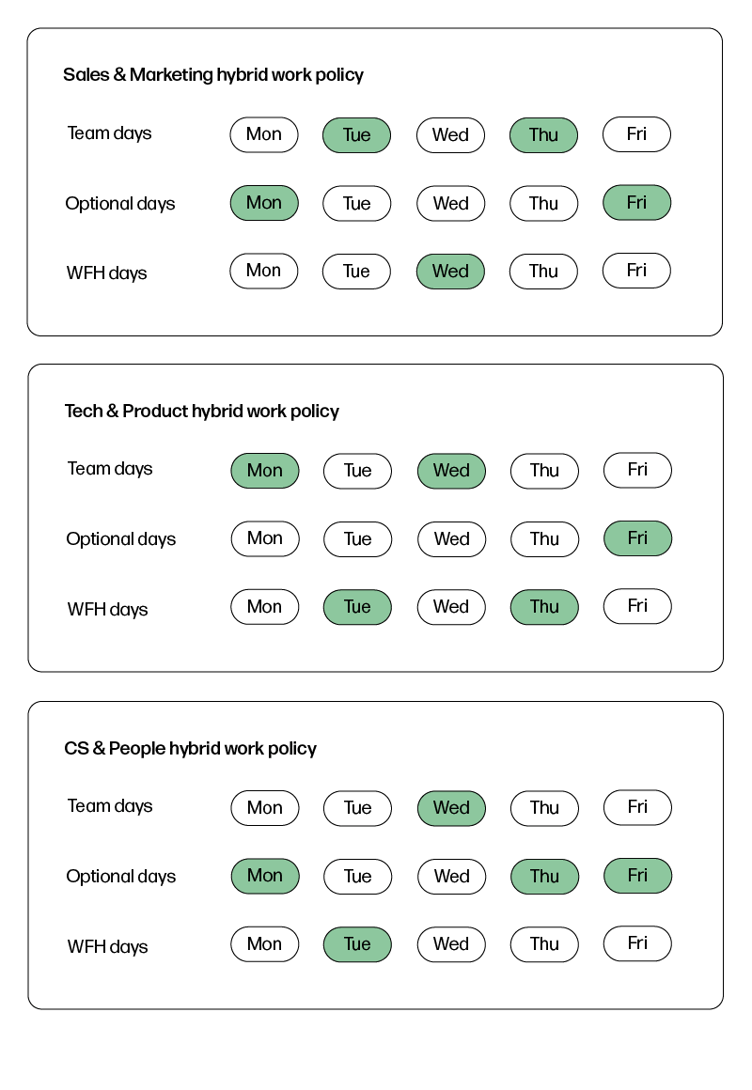 Pros:
Pros:
- More efficient use of space
- Could lead to cost-saving further down the line
- Allows for flexibility within teams
- Frequent face-to-face interaction between teams and team members
Cons:
- Limits cross-pollination with other teams
- Reduces the amount of wider ‘company moments’
Fixed day policy
An alternative approach, and one suited to growing companies, is to have fixed days for everyone in the business to come together in the office. The amount of days is a variable, but this type of hybrid working strategy is all about in-person moments that help drive company culture, collaboration and performance.
Bringing everyone together (as opposed to certain teams) allows businesses to remain agile and communicate more effectively as and when there are updates that employees need to be made aware of.
Here's an example from a different client who wanted to prioritise wider company moments on days in. They have a weekly kick-off on a Monday morning in their social space, and a company lunch on a Wednesday. Outside of their two mandatory days, they encourage each team to choose one additional day on which to align.
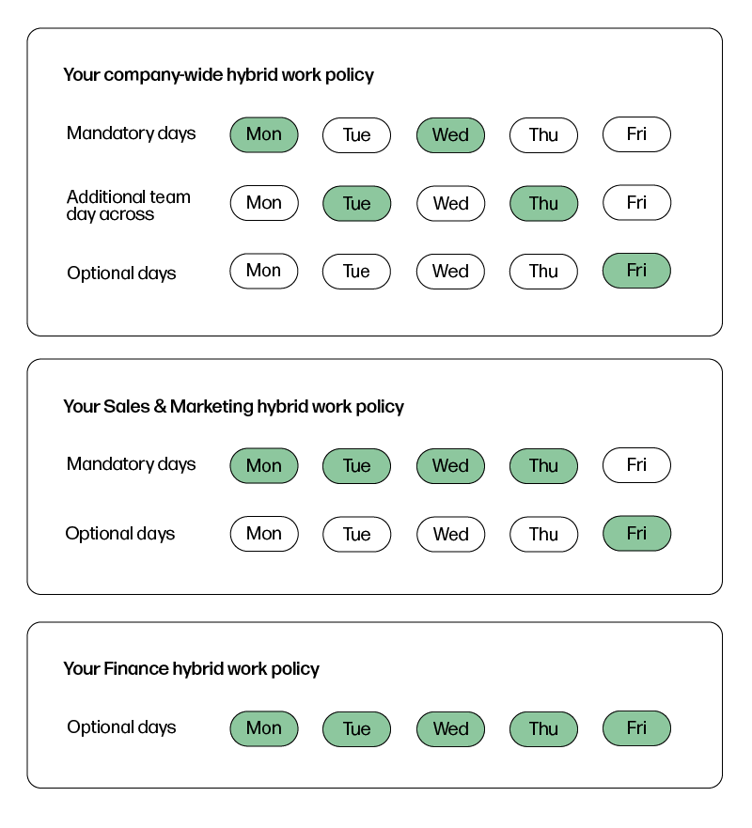 Pros:
Pros:
- Great for cross-pollination
- Effective communication at all levels
- Streamlines problem-solving and innovation
- Boosts company culture
Cons:
- Smaller spaces could feel crowded
- Distractions more likely to occur
The caveat with this strategy is that the in-office days need to be planned intentionally in order to get teams to buy in to the approach. Consider how you can elevate the experience that employees are having when they come into the office (what can’t they get at home?) and build your days around those moments.
Flexible policy
This is the least structured of the three options, giving employees greater autonomy to plan their own in-office days and align with their colleagues on their own accord.
This needs to be supported with rough guidance on expected days in over the course of a week, fortnight or month to have any chance of being impactful, so you'll need to consider how important keeping track of attendance is to you and the wider business objectives.
Pros:
- Improved work-life balance for employees
- Potential to reduce office footprint in the long run
Cons:
- No guarantee that the office won't be empty
- Limited in-person interactions and cross-pollination
- Hard to keep track of attendance
- Difficult to embed new employees into the culture
6 steps to implementing a hybrid working policy
So, you know you want to invest your time in creating a hybrid strategy for your business, but where do you start? It can often be the most difficult part, but the reality is that any implementation is likely to have a bigger impact than no policy at all. With this in mind, here are our six key steps to consider.
- Step 1: The pre-requisites
- Step 2: Involving your team
- Step 3: Communication
- Step 4a: Company rituals
- Step 4b: Implementing rituals
- Step 5: Workspace design
- Step 6: Review and evolve
Step 1: The pre-requisites
As we've prefaced, every business is unique. Each policy will be specific to how your teams work best, the customers you serve, what your mission is and so much more. This list isn't exhaustive, but we've detailed some of the important areas we ask the businesses we work with to focus on.
1. Setting objectives & success metrics
Before diving into the details of different options, it’s important to first outline what your objectives are, any challenges you’re facing and how you’re hoping to overcome them. This could be a number of reasons, from being more space and cost-effective to creating a stronger company culture.
Your objectives will ultimately help you set your success metrics. For example:
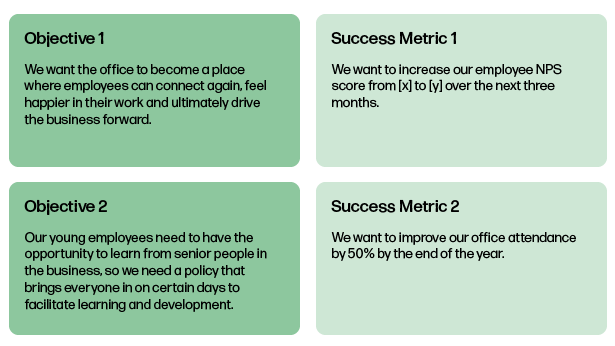
2. Employee preferences
You can’t be everything to everyone, but a hybrid working policy that fails to factor in the preferences and ideas your employees may have will often fall short of the mark.
If you’re moving from having no policy at all to one that requires people to be in on specific days, it’s important to consider the implications (such as the cost, commute and changes to work-life balance).
To help tackle this, one option is to send a survey round to employees asking them to detail any specific requirements that need to be considered, and crucially what they’d like to gain from in-office days.
It's important this isn't treated as a free-for-all for requests, but instead an opportunity for employees to make it clear what they value when they're in the office, which will enable you to begin shaping your policy and subsequently your office design.
It may be possible to ask every employee, but an alternative would be to ask team leads or department heads for an overview, which should paint a picture of the business’s unique needs.
3. Who you are
How do your teams like to work? What defines your company culture? What makes your business unique? These are all things that need to be considered before implementing a hybrid policy. Each business is unique, and each attribute will inform a different part of your strategy.
For example, one business we spoke to recently have switched from a flexible policy to one with fixed days. They have been actively hiring and have a relatively high percentage of junior employees across the company, so the aim was to land on a model that provided these team members with the opportunity to learn from senior colleagues and ask questions that they may not be able to when working remotely.
Step 2: Involving your team
By involving the team in the decision-making process, it's much easier to foster a sense of ownership and buy-in among employees. When employees feel included and have a voice in shaping the policy, they are more likely to embrace and support the changes and understand the rationale behind the 'why'.
This should provide you with adequate feedback on any big changes that are about to take place, and ensure you aren't overlooking any specific needs or requirements.
At Kitt, we used Typeform to send a survey to everyone in the business, asking for their feedback on proposed changes. The input should be used to design something that works for everyone (where possible!).
Here are some questions to consider when creating your survey:
- Would the transition from [day] to [day] be difficult for you?
- Are you concerned about the potential change?
- Is there anything else that we would need to consider or that you would like to share?
If any of the answers are 'yes', consider following up with a more detailed question that they're able to respond to, such as:
- Please tell us why this would be difficult for you.
- What could we do to mitigate these challenges?
Note: be sure to ask for their name so that you can do the relevant follow-up with them in private.
Step 3: Communication
Communicating your hybrid policy with employees is crucial because it allows you to establish clarity and set expectations. If employees know when they’re expected to be in the office and you’ve answered the ‘why’ they need to be in question, it’ll help navigate any uncertainty.
Moving to mandated days when your existing strategy is entirely flexible is a big change for any business, and the reality is that you may have to deal with some resistance.
The clarity you provide is how you achieve buy-in; you’re giving people the opportunity to be in or out, and ultimately if your policy is aligned with the wider mission and vision of the business the aim should be retention of those who are in.
When communicating your strategy with your employees, consider the following.
1. Individual meetings with team leads
Take time to sit down with each team lead or department head to discuss the policy. This will allow them the opportunity to ask any questions ahead of the roll out to the wider company, and it will also empower them to be able to explain the what and the why to everyone in their team.
2. Written communication
Outline your policy in an easily accessible place, such as the company intranet platform or HRIS. This document should include clear guidelines on work arrangements, expectations, and any relevant procedures, and should also be shared via email.
3. In-person communication
Share your policy with the team in an in-person setting (for those who can attend), such as an all-hands or weekly kick-off with the whole company.
This allows you to articulate the reasons you are making these changes in a clear and concise way and also provides employees with a platform to ask questions and receive immediate answers.
4. External release
This doesn’t necessarily need to be high on the list of priorities, but an extra thing to consider is putting your policy out in the world for others to see.
There are a few ways to do this, such as a company blog or using LinkedIn’s hybrid workplace feature, but regardless of how you choose to do it, it’s a great opportunity to be a thought leader and showcase your mission and vision to future employees.
Step 4a: Fixed-day rituals
Incentives have gone through a huge shake-up post-covid. In an environment where business success has to be the priority above all else, employee perks and workplace incentives need to be grounded in your ‘why’ – and ultimately support your mission in a holistic way. Company moments, or 'rituals', are a great way to do that. Here are a few examples.
Breakfast kick-offs
One effective way to enhance your company culture and foster a sense of alignment among your employees is by hosting regular kick-off breakfasts.
These can happen on any given day but are more effective at the beginning of the week as they provide a valuable opportunity for your team to align on objectives and goals.
At Kitt, we host these on a Monday, because typically Monday mornings are associated with the challenge of transitioning from a relaxed weekend mindset to a productive work mindset.
By kickstarting the week with a company moment like a breakfast, you create a designated time and space for employees to align their goals, set priorities, and get focused for the week ahead.
These breakfasts provide an ideal platform for important announcements, updates, and information sharing. You can use this time to communicate company news, share successes, recognise achievements, and address any challenges or upcoming projects.
Town halls
Similarly to breakfast kick-offs, town halls (or end-of-week wrap-ups) are a popular company ritual that has been adopted by SMEs in recent times. These provide a valuable opportunity for teams to come together, share updates, celebrate wins and address business challenges.
They’re a great platform for open and direct communication between leadership and employees. By hosting them in the office, you create a face-to-face interaction where anyone can ask questions, share concerns, and receive immediate responses. This helps foster transparency, build trust, and strengthen the overall communication within the business.
Some of the businesses we work with have opted to have an anonymous ask-us-anything section of their town halls, where employees who may not feel comfortable asking questions openly can submit their thoughts ahead of time (and anonymously) but still receive answers in real-time.
Learning & development events
One way to boost a culture of learning and development is to consider hosting training workshops or fireside chats with industry professionals on in-office days. These could be company-wide, or for specific teams on a rotating basis.
These can be incredibly effective for growing companies and businesses with a high proportion of young/junior professionals, facilitating an environment in which they have the opportunity to ask questions, develop their skillset and crucially access support that isn’t available to them when working from home.
Other examples
The list is endless, and each idea can be tailored to your team and your objectives, whether that be driving company culture or opening up clearer communication channels throughout the week.
Here are a few other examples from some of the businesses we work with to take inspiration from.
- Team lunches organised by the company
- Wellbeing incentives (yoga in the office before work, for example)
- Monthly or quarterly team socials
- Gym membership discounts to spaces close to the office
- Bike servicing surgeries to encourage those that want to cycle in
- Accommodating spaces such as prayer, quiet or parents’ rooms
Step 4b: Implementing rituals
Coming up with these company rituals or incentives is one thing, but it’s another to make them stick and ensure the return of your employees isn’t just a flash in the pan.
Here are a few tips to consistently drive your company culture.
Set a regular schedule
Consistency is key. Determine a fixed time and day each week for your company rituals, allowing employees to plan their schedules accordingly. If it’s going to take up a chunk of time, give them enough notice so they can rearrange any other commitments if necessary.
Facilitate interaction
Create an environment that encourages open communication and interaction. Give people the opportunity to ask questions or share their thoughts on what’s being discussed. One tip is to plant a few questions so that others feel more comfortable raising their hand.
Seek feedback
Regularly gather feedback from your employees to understand their experience and suggestions for improvement. This feedback loop allows you to refine and optimise based on the needs and preferences of your team.
Making hybrid work a success requires ongoing effort and a genuine commitment to the well-being and engagement of your employees. Regular company moments that bring people together will help to create a positive atmosphere that aligns your team, fosters connection and strengthens your business as a whole.
Step 5: Workspace design for hybrid working
Office design has evolved significantly over the last few years. With employees now replicating the typical desk set up in home offices and other remote settings, the office itself has a responsibility to provide the workforce with an experience that makes the commute worthwhile.
Businesses are having to think about workspace design in an entirely new way, from what was at its core ‘workspace’, to a home that reflects brand identity, company values as well as aspirations. Crucially, the design of the office now needs to meet the changing needs and preferences of the hybrid workforce.
Layout
Before the pandemic changed the way that we work, the traditional split between desk and other areas in the office was around 70/30. Now, with collaboration taking centre stage, it’s much closer to 50/50 – and in some cases it’s as low as 30/70.
It’s important that your workspace now has a balance of collaboration and focus areas, to enable teams to do their best work when they’re in the office. One way that to approach this is with the neighbourhood model, which we use in the early design stages with some of our clients.
These models are widely affected by specific team and business goals, as well as the type and size of the company. That being said, here’s an example of a business that chose to adopt a neighbourhood model, in order to maximise both intra and inter-team collaboration.
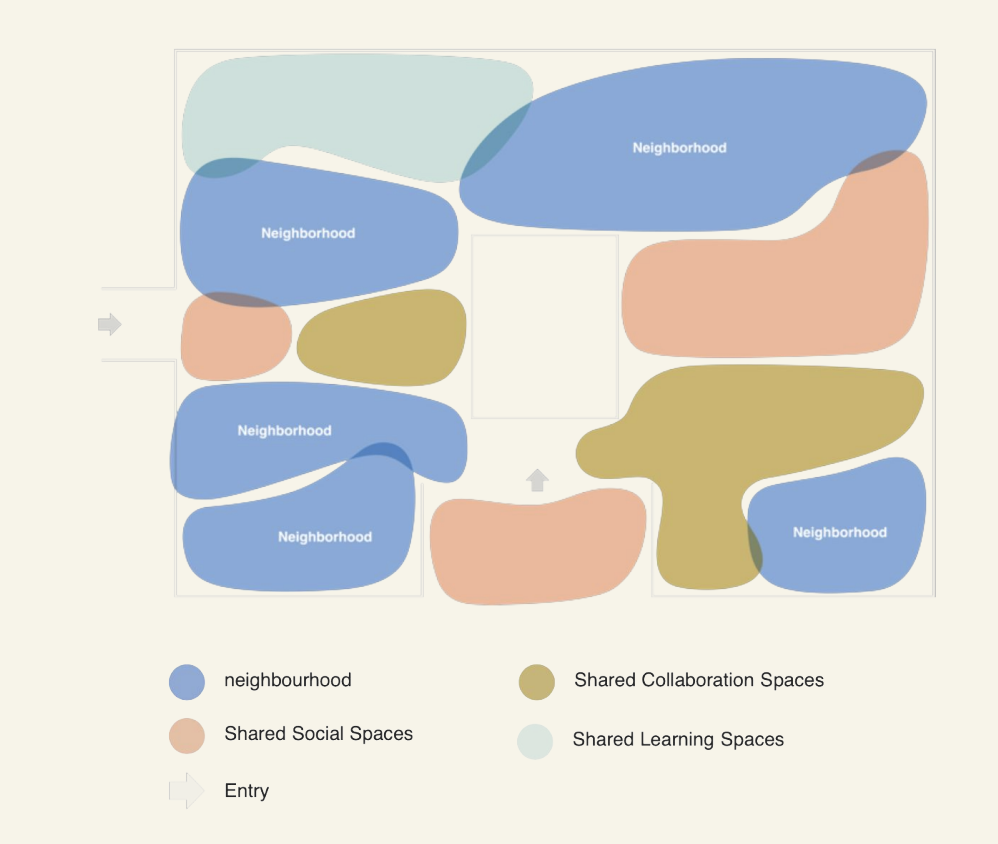
They decided that they didn’t want to do hot-desking, so their space was designed to enable certain teams to work collectively. Teams that need to align frequently are sat in similar areas, but there is also plenty of social and collaboration space to enable other teams to connect and innovate.
Looking for more inspiration? Here are a few other neighbourhood models from our clients with a range of workspace goals.
- Model 1: Marketing Agency (25 employees)
- Model 2: Fintech (80 employees)
- Model 3: Professional Services (170 employees)
Model 1: Marketing Agency (25 employees)
Primary goal:
- Maximise those in-person moments to drive collaboration and big-thinking ideas.
Recommendations:
- Create large social and collaboration areas for employees to maximise in-person interactions on their days in
- Keep allocated desk space to a minimum, as the majority of execution work is done when employees work from home
- Provide plenty of meeting room spaces for collaborative moments that require more focus

Model 2: Fintech (80 employees)
Primary goal:
- Greater alignment across the business and in particular sales and marketing.
Recommendations:
- Use collaboration and break out areas to create connections (not divisions) between teams, allowing them to get together for quick touchdown moments or more intentional information sharing
- Create a large enough tea point/social space to host a weekly all-hands to ensure the whole business is aligned

Model 3: Professional Services (170 employees)
Primary goal:
- Build a learning and development culture for their team which has a high proportion of junior/graduate employees
Recommendations:
- Build a specific area for training, which can be used for external sessions and internal coaching between senior and junior members of staff
- Consider having smaller breakout and collaboration areas within the sales neighbourhood so that employees can receive immediate, informal feedback on calls

Once you have landed on a model and a layout that works for your business, you’ll need to consider the types of spaces you’ll be creating. Here are some examples to take inspiration from.
Types of spaces
People are seeking variety in the workspace. They want different types of seating, spaces to socialise, areas to hold collaborative meetings but also focus spaces to be able to follow up on those meetings.
When you’re thinking about the design of your own office, it’s really important to consider how you can start to incorporate these types of spaces to enable your employees to do their best work.
Type 1: Collaborative spaces
According to a Steelcase report, spaces for hybrid collaboration (64%) are the number one thing employees are now looking for in the post-pandemic office. There are a number of ways to bring these into your office design, but it’s important to consider how your teams like to work.
For example, you may have teams that thrive in a more open environment, where they can bounce ideas off of not just those at the table, but others in the office too.
In this example, noise reduction may be less important, and therefore you can be relatively flexible with where these areas are positioned in your space.
This could be an open collaboration area, or a high table in the heart of your space for those quick touchdown moments that enable agile working and fast-paced decision-making.
Steelcase
(Images: Steelcase)
Alternatively, it may be crucial to provide your team with the space and privacy to conduct more intentional, focused collaboration. If this is the case, consider creating closed-off areas with booths or dividers, or even soundproof options like meeting pods.
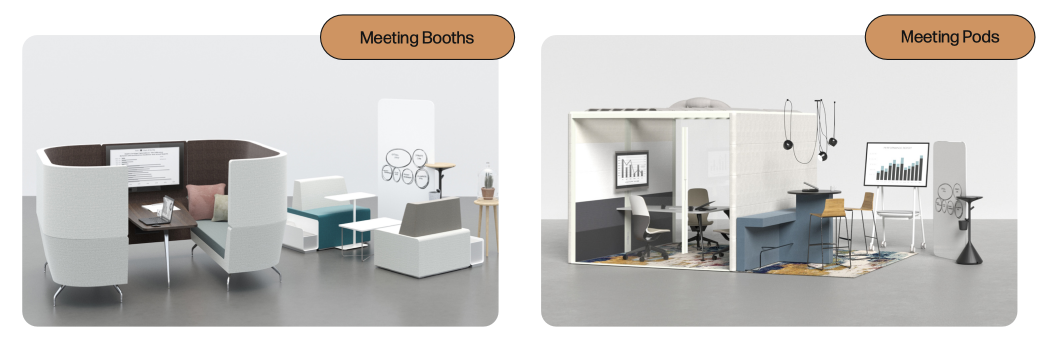
Type 2: Flexible spaces
Using flexible spaces is a great way to optimise your office in a hybrid model. This is really beneficial for businesses with a fixed-day policy because it enables teams to make adjustments to the space easily depending on different occupancy levels and uses throughout the week.
A few examples of this:
- Movable screens and TVs
- Flexible collaboration areas that can be reconfigured
- Obvious and simple movability (wheels on chairs and tables)
- Moveable acoustic panels for visual and acoustic privacy
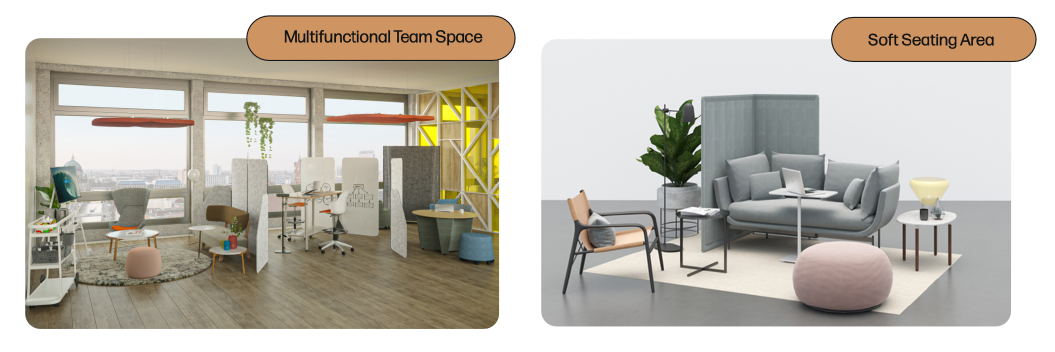
Type 3: Focus areas
Despite the shift towards collaborative, open-plan spaces post-pandemic, it’s really important that you don’t forget about focus spaces. It’s unrealistic that anyone can collaborate for an entire day, and there will often be meeting prep or follow-up actions that need to be worked through when in the office.
The same Steelcase report indicates that after collaborative spaces, single-person focus spaces (62%) and privacy (61%) are the top things employees feel that they need to support them in the world of hybrid working.
You could look to incorporate private break-out rooms and/or booths in bigger spaces, but if you’re working with less space it could be something as simple as desk dividers so that your team are able to get their heads down and avoid distractions.
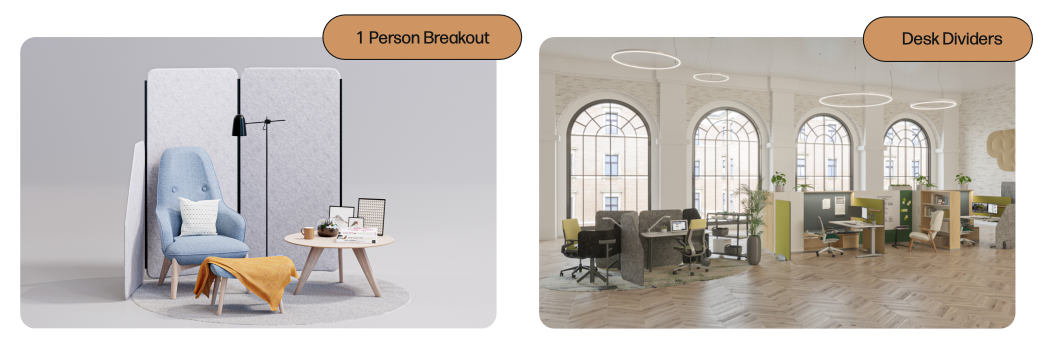
One trend we’ve seen in recent times is businesses creating quiet rooms in their office. These serve multiple purposes, from allowing employees to focus on their work with no distractions to prayer rooms and a space in which people can take a few minutes away from their work to refocus or relax.
Ultimately, it’s about understanding how your teams like to work and what you want to achieve from your space, and intentionally designing the office around that.
Step 6: Review and evolve
The business landscape is always shifting, and what worked before might not work as well in the future. Once your hybrid strategy is in place, it’s a good idea to pencil in an initial review period so that you can continue to evolve the processes you have in place, meeting changing needs and new requirements.
By gathering feedback from employees, you can make improvements based on their experiences. Ultimately, it helps create a work environment that supports your team’s well-being and helps them thrive.
Choosing the right hybrid strategy to bring employees back into the office is a significant decision for any business. By considering the unique needs and preferences of your employees, assessing who you are as a business and what you want to achieve, you’ll be creating a balanced and flexible approach that can stand the test of time.


